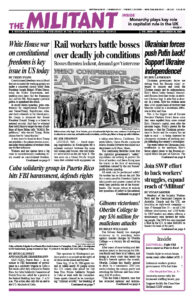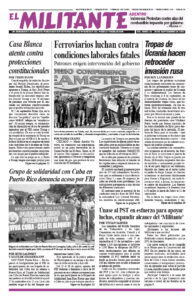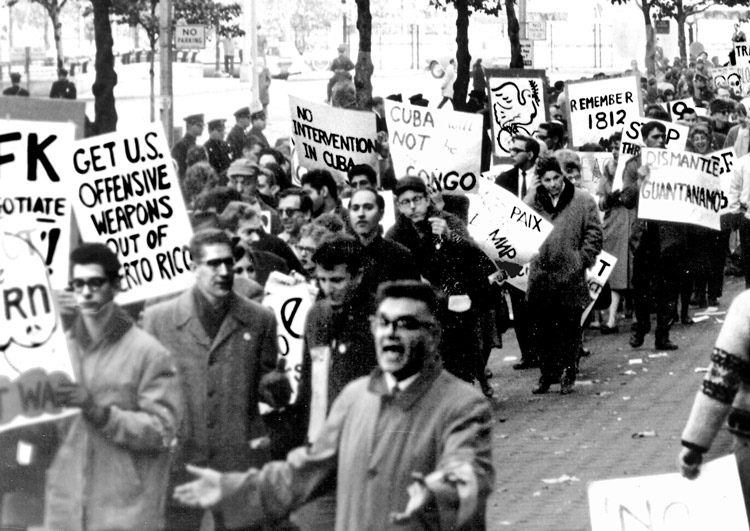The 60th anniversary printing of October 1962: The ‘Missile’ Crisis as Seen from Cuba by Tomás Diez Acosta is one of Pathfinder’s Books of the Month for September. This excerpt from the book’s preface tells how the Cuban people and their revolutionary government, backed by protests in the U.S., defended their socialist revolution against Washington’s threat of war. Copyright © 2002. Reprinted by permission of Pathfinder Press.
In October 1962, during what is widely known as the Cuban Missile Crisis, Washington pushed the world to the precipice of nuclear war. Scores of books on the subject have been written by partisans of Washington and of Moscow. Here, for the first time, the story of that historic moment is told in full from the perspective of the central protagonist, the Cuban people and their revolutionary government. …
On April 19, 1961, after fewer than seventy-two hours of hard-fought combat, the Cuban armed forces, national militias, revolutionary police, and fledgling air force had dealt a stunning defeat to a U.S.-trained, -organized, and -financed mercenary invasion force of some 1,500 at Playa Girón close by the Bay of Pigs on Cuba’s southern coast. From that day on … U.S. policy makers at the highest levels acted on the conclusion that the revolutionary government of Cuba could be overthrown only by direct U.S. military action. And they marshaled seemingly limitless resources to prepare for that moment. Under the personal guidance of the president’s brother, Attorney General Robert F. Kennedy, “Operation Mongoose,” with its multifaceted plans for sabotage, subversion, and assassination of Cuba’s revolutionary leaders, was unleashed to pave the way.
In October 1962, when U.S. spy planes photographed Soviet missile launch sites under construction in Cuba, the U.S. rulers recognized that the military and political costs of such an invasion were being qualitatively transformed, and they initiated the adventure detailed in these pages.
Most U.S. commentators treat the events of October 1962 as a Cold War showdown between the two superpowers, in which Cuba was at best a pawn, at worst a raging mute offstage. In that scenario the people of Cuba do not exist, nor in fact do the tens of thousands of Americans across the country who acted to oppose imperialist Washington’s preparations for a military assault.
As Diez demonstrates in these pages, however, the roots of the crisis in the Caribbean lay not in Washington’s Cold War with the Soviet Union, but in the drive by the U.S. government to overthrow the “first free territory of the Americas.” Kennedy’s acceptance of Khrushchev’s offer to withdraw the missiles — an offer broadcast worldwide over Radio Moscow without even informing the Cuban government — was how the stand-down of the two strategic nuclear powers was announced. But it was the armed mobilization and political clarity of the Cuban people, and the capacities of their revolutionary leadership, that stayed Washington’s hand, saving humanity from the consequences of a nuclear holocaust.
Divergent political courses pursued by the Cuban and Soviet governments marked each step. The Soviet leadership, seeking a way to enhance its strategic military position and to counter the Jupiter missiles the U.S. had recently installed in Turkey and Italy, insisted on secrecy and attempted deception. Cuba took the moral high ground, arguing from the beginning for the public announcement of the mutual assistance pact and the right of the Cuban people to defend themselves against U.S. aggression.
The defeat of the invasion force at the Bay of Pigs had bought precious time for Cuba to organize, train, and equip its Revolutionary Armed Forces. Even more decisive, the people of Cuba used that time to consolidate the agrarian reform; win the battle of the literacy campaign; build schools, homes, and hospitals; extend electrification; advance social equality among Cuba’s working people; and strengthen the worker-farmer alliance that was the bed-rock of the revolution and of the respect Cuba had earned among the world’s toilers. As they navigated the contradictory dialectic of the greatly appreciated aid they received from the USSR, the Cuban people were not only defending themselves against the Yankee predator. They stood for the future of humanity, as they stood down the power of U.S. imperialism.
And despite all odds they prevailed.
On October 26, at a decisive moment in the unfolding crisis, John F. Kennedy asked the Pentagon for an estimate of the U.S. casualties that would be incurred during the invasion they were weighing. He was informed that the Joint Chiefs of Staff expected 18,500 casualties in the first ten days alone — greater than the casualties U.S. troops would suffer in the entire first five years of fighting in Vietnam. And knowledgeable Cuban military personnel say U.S. casualties would have been far greater. From that moment on, Kennedy turned White House strategists away from their well-advanced plans to use U.S. military forces in an attempt to overthrow the revolution. The political price such body counts would entail continues to this day to hold off any direct U.S. military attack against Cuba. …
Inside the United States, a widely promoted myth has it that ordinary Americans everywhere were so consumed by panic over the danger of nuclear attack that they, too, were not a factor during these historic events. Those of us who lived through those days of crisis as active political people, however, know the extent of that lie. …
Small though some of these protest actions were, we never felt isolated. To the contrary, we saw ourselves as part of the immense majority of humanity, starting with the workers, farmers, and young people of Cuba itself. We knew they would never go down on their knees before the nuclear blackmail of the Yankee colossus, and we were determined to stand with them. Justice and history were on our side. Far from any sense of panic or helplessness, we were conscious that our actions had weight, that minute by minute the men in the White House were calculating the political consequences of their potential moves. Each hour they postponed invading, each day they didn’t launch a nuclear missile, was a victory. And each day our actions grew larger, and spread to more cities and towns across the United States.


